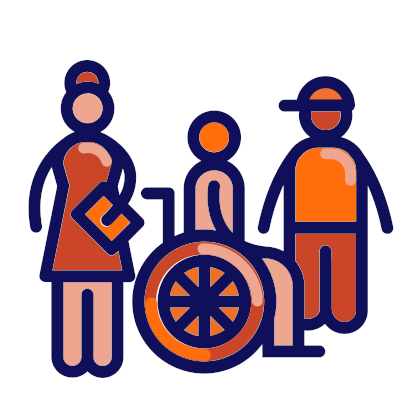Improving well-being at school

Since well-being has many facets, improving students’ well-being in schools requires a whole-school approach, involving both teachers and parents.
Schools should provide lessons focused on the responsible use of the Internet, the need to adopt a healthy lifestyle and how to prevent or cope with health problems, in collaboration with those involved, including health and social services, local authorities and civil society organisations.
Facts & figures
About 60% of school students report getting very tense when they study.[1]
Just over 60% of girls and 40% boys say they feel very anxious about doing tests at school, even when they are well prepared.[2]
Over 70% of parents say they would choose to send their children to a school with below-average exam results if students were happy there.[3]
What is well-being?
Well-being is the experience of health and happiness. It includes mental and physical health, physical and emotional safety, and a feeling of belonging, sense of purpose, achievement and success.
Well-being is a broad concept and covers a range of psychological and physical abilities. Five major types of well-being are said to be:
- Emotional well-being – the ability to be resilient, manage one’s emotions and generate emotions that lead to good feelings
- Physical well-being – the ability to improve the functioning of one’s body through healthy eating and good exercise habits
- Social well-being – the ability to communicate, develop meaningful relationships with others and create one’s own emotional support network
- Workplace well-being – the ability to pursue one’s own interests, beliefs and values in order to gain meaning and happiness in life and professional enrichment
- Societal well-being – the ability to participate in an active community or culture.
Overall well-being depends on all these types of functioning to an extent.[4]
“Having meaning and purpose is integral to people’s sense of well-being. Well-being involves far more than happiness, and accomplishments go far beyond test success.”[5]
Why is well-being important at school?
Well-being is important at school because schools have an essential role to play in supporting students to make healthy lifestyle choices and understand the effects of their choices on their health and well-being. Childhood and adolescence is a critical period in the development of long-term attitudes towards personal well-being and lifestyle choices. The social and emotional skills, knowledge and behaviours that young people learn in the classroom help them build resilience and set the pattern for how they will manage their physical and mental health throughout their lives.
Schools are able to provide students with reliable information and deepen their understanding of the choices they face. They are also able to provide students with the intellectual skills required to reflect critically on these choices and on the influences that society brings to bear on them, including through peer pressure, advertising, social media and family and cultural values.
There is a direct link between well-being and academic achievement and vice versa, i.e. well-being is a crucial prerequisite for achievement and achievement is essential for well-being. Physical activity is associated with improved learning and the ability to concentrate. Strong, supportive relationships provide students with the emotional resources to step out of their intellectual ‘comfort zone’ and explore new ideas and ways of thinking, which is fundamental to educational achievement.
Well-being is also important for developing important democratic competences. Positive emotions are associated with the development of flexibility and adaptability, openness to other cultures and beliefs, self-efficacy and tolerance of ambiguity, all of which lie at the heart of the Council of Europe Reference Framework of Competences for Democratic Culture.
What are the challenges?
One of the challenges of trying to promote young people’s well-being in school is the multi-faceted nature of well-being. There are a number of different types of well-being, all of which need to be promoted to some extent to create an overall sense of well-being in a person. So, it is not possible to improve students’ well-being at school through single interventions or activities. Rather it requires the development of a ‘culture’ of well-being throughout the whole school and the active involvement of the whole staff, teaching and non-teaching, which can be difficult to achieve.
The promotion of well-being may sometimes appear to conflict with other school priorities, such as academic standards. Unreasonably high expectations, a regime of constant testing or an over-emphasis on the importance of academic performance may actually undermine student well-being.
In many cases schools do not have the freedom to make the changes to school life which might most benefit student well-being. They may have little control, for example, over formal examinations and tests, the content of curricula, the length of the school day or the physical school environment.
Nor have schools control over the many out-of-school influences on student well-being. What happens in the home and the family, local communities or social media can have as much, if not more, influence on student well-being as anything in school.
Finally, developing a sense of well-being in students is made all the more difficult when school staff themselves do not have a positive sense of well-being. Well-being at work is strongly related to stress. Stress at work is related to workload, quality of professional relationships, level of autonomy, clarity about one’s role, availability of support and the opportunity to be involved in changes which affect one’s professional life. High levels of stress can lead to demotivation, lack of job satisfaction and poor physical and mental health, which has a knock-on effect on students’ own well-being.
How can schools get active?
Addressing student well-being at school begins with helping students feel they are each known and valued as an individual in her or his own right, and that school life has a meaning and purpose for them. This can be achieved in a variety of small ways, the cumulative effect of which can have a very powerful influence on students’ sense of well-being. These include:
- providing opportunities for all members of the school community to participate in meaningful decision-making in school, e.g. through consultations, opinion surveys, referenda, electing class representatives, student parliaments, focus groups, in-class feedback on learning activities, and an element of student choice in relation to topics taught and teaching methods used;
- developing a welcoming environment where everyone at school can feel supported and safe through access to meaningful activities, e.g. clubs, societies, interest groups and associations dealing with issues of concern to young people, including health;
- taking steps to reduce the anxiety students feel about examinations and testing through the introduction of less stressful forms of assessment, e.g. formative assessment, peer assessment and involving students in the identification of their own assessment needs;
- using teaching methods that contribute to a positive classroom climate and well-being, e.g. cooperative learning, student-centred methods, self-organised time, outdoor activities;
- finding curriculum opportunities to talk about well-being issues with students, e.g. healthy eating, exercise, substance abuse, positive relationships;
- integrating democratic citizenship and education for intercultural understanding into different school subjects and extra-curricular activities, e.g. openness to other cultures in Religious Education, knowledge and critical understanding of human rights in Social Science, empathy in Literature;
- introducing student-led forms of conflict management and approaches to bullying and harassment, e.g. peer mediation, restorative justice;
- improving the physical environment of the school to make it more student-friendly, e.g. new furniture and fittings, carpeted areas, appropriate colour schemes, safe toilet areas, recreational areas;
- encouraging healthier eating by providing healthy options in the school canteen, e.g. avoiding high amounts of sugar, saturated fats and salt;
- working with parents to enhance students’ achievement and sense of purpose in school, e.g. on healthy food, safe internet use and home-school communications.
Individual initiatives like these can be brought together at the whole-school level through a policy development process which ‘mainstreams’ well-being as a school issue. This means giving attention to the potential effects of new policies on individual well-being - of students, teachers and others. Addressing student well-being at school always goes hand in hand with action to protect the health and well-being of teachers and other staff at school.
[1] OECD (2017). PISA 2015 Results (Volume III), p.40. Students’ Well-Being. Paris, France: OECD Publishing.
[3] Cowburn & Blow, ‘Wise up - Prioritising wellbeing in schools’
[4] Psychology Today, January 2019.
[5] Hargreaves & Shirley (2018), ‘Well-being and Success. Opposites that need to attract’.
 Resources on Improving well-being at school
Resources on Improving well-being at school
 Related schools projects
Related schools projects
Address: Proin Stratopedo StrempeniotI, 56701 Neapoli, Thessaloniki
Country: Greece
Project: Our voice is our power!
 Working language during the project:
Working language during the project:
- Greek
- English
 Themes of the Council of Europe campaign “FREE to SPEAK, SAFE to LEARN - Democratic Schools for All” covered:
Themes of the Council of Europe campaign “FREE to SPEAK, SAFE to LEARN - Democratic Schools for All” covered:
- Making children’s and students’ voices heard
- Addressing controversial issues
- Preventing violence and bullying
- Tackling discrimination
- Improving well-being at school
 Competences from the Reference Framework of Competences for Democratic Culture (CDC) addressed and where / how they were integrated:
Competences from the Reference Framework of Competences for Democratic Culture (CDC) addressed and where / how they were integrated:
- Co-operation skills
Activities and creation of educational material. - Respect
Activities and creation of educational material [eg a radio show that was broadcast by a Greek national radio station (ERT3]) . - Knowledge and critical understanding of the world:politics, law, human rights, culture, cultures, religions, history, media, economies, environment, sustainability
Activities and creation of videos and other educational material about human rights (anti-bullying), culture, cultures and history (Europe and other countries), environment.
 Target group age range:
Target group age range:
- 15-19
 Level of education:
Level of education:
- Upper secondary education
Short description of the project:
This project focuses on the idea of active citizens in the European Union which was implemented in a Senior High School during the school year 2017-2018, within the framework of the "Ambassador School Programme", "Teachers 4 Europe" and eTwinning programmes. Two teachers of different specializations collaborated with students from all grades in order to foster their competences for democratic culture and become active citizens on themes such as human rights, democracy and environment. With the help of experiential techniques and technology, and with the motivation of some older videos and sites/blogs that the two teachers have created in previous years with their older students, they created some new videos, a radio show that was broadcast by a Greek national radio station, some new sites/blogs and other educational material.
 Aims/objectives
Aims/objectives
Τhis project aimed to familiarise pupils with the European Union and the concept of active citizens in the European Union. It invited students and teachers to reflect on current problems (human rights, refugees, environmental problems, bullying, democratic & digital citizenship etc.) and act upon them as active citizens. Moreover, it created opportunities for social interaction of young people by fostering dialogue among students from different countries and developing a mutual understanding.
 Expected results/outcomes
Expected results/outcomes
During the evaluation of the practice, the teachers observed that students: a) managed to successfully process and reformulate the information provided through the project, b) developed their decision-making ability, c) became familiar with modern technology, d) reinforced their active involvement.
The knowledge provided during the activity was related to real life, the protagonists being the students themselves: without their involvement, nothing could be accomplished, and no educational goal could be reached. Both the teachers and the students embraced different ways of perceiving and interpreting reality and committed themselves to using them. More particularly, the students were asked to talk about respect, religious notions and European values and to demonstrate what they can actually do with all they have learned, through their own work.
The project focused on active citizenship, migration, human rights, awareness of policies for migration, cultivating the interdisciplinary spirit among students and teachers, collaboration and resilience and learning the values of respect. The students discussed, criticized, became aware of the current situation and realized that we have to work together for a free, socially just and democratic Europe of the future that places its respect on the environment and humanity as its main priority.
 Changes
Changes
Both the teachers and the students adopted such an attitude that enabled them to view the world in various different ways: to describe it, to interpret it, to check it, to experience it, to analyse it, to depict it, to reenact it. And all this was done in more ways than one, using various “languages”.
Acquired skills: educational material study, digital literacy, inclusion, cultivated empathy through activities, engaged problem solving, critical thinking, improved language skills and international collaboration, encouragement of interest in science, performance–based assessments.
 Challenges you faced
Challenges you faced
The challenges that we faced were to enhance the understanding of students for the important role they play in interpreting the diversity of the "other" through a holistic approach of diversity through research, promotion and study of personal experiences, needs and desires of the students themselves.
As far as our school is concerned, the students were accepted after taking and passing a special examination or currently at random (with a draw) and, therefore, they do not necessarily come from the area around the school, but from various municipal districts. At the very beginning of the school year, an attempt has been made to detect and accommodate the various student learning styles by taking into account the students’ extracurricular activities.
Moreover, we have tried to cultivate European consciousness and identity through the active participation of pupils on European platforms and the empowerment of European values and the acquaintance with the religious, cultural and geographical diversity of Europe and the contact of students with its arts and culture, so that Europe can take a more meaningful approach, especially in the difficult times we are experiencing with fanaticism, nationalism and homogenization.
Finally, an attempt was made to exploit the pre-existing knowledge of pupils. The research hypothesis was that students would be better met in a familiar and popular interface (digital maps) and would feel closer to the new information and European values. Cartographer-students were asked to reconfigure the religious and cultural past of the people of Europe and link it to today.
 Time-frame of the project:
Time-frame of the project:
During the school year 2017-2018 (some parts were created during the school years 2015-16 and 2016-17 and were used as educational material for the school year 2017-18)
 Council of Europe materials on citizenship and human rights education used while preparing or implementing your practice:
Council of Europe materials on citizenship and human rights education used while preparing or implementing your practice:
- Reference Framework of Competences for Democratic Culture
- Living Democracy - manuals for teachers
- Addressing violence in schools through EDC/HRE
- All Different – All Equal
- Managing controversy
- Teaching controversial issues-training pack
- Compass
- Compasito
- Human Rights and Democracy Start with Us – Charter for All
- Freedom(s) - Learning activities for secondary schools on the case law of the European
- How all Teachers Can Support EDC/HRE: A Framework for the Development of Competences
- Multimedia Material (ex. video “Beat Bullying”, series of cartoons “Democracy and Human Rights at School”, video “Corporal punishment at school: how two parents decided to change things”)







